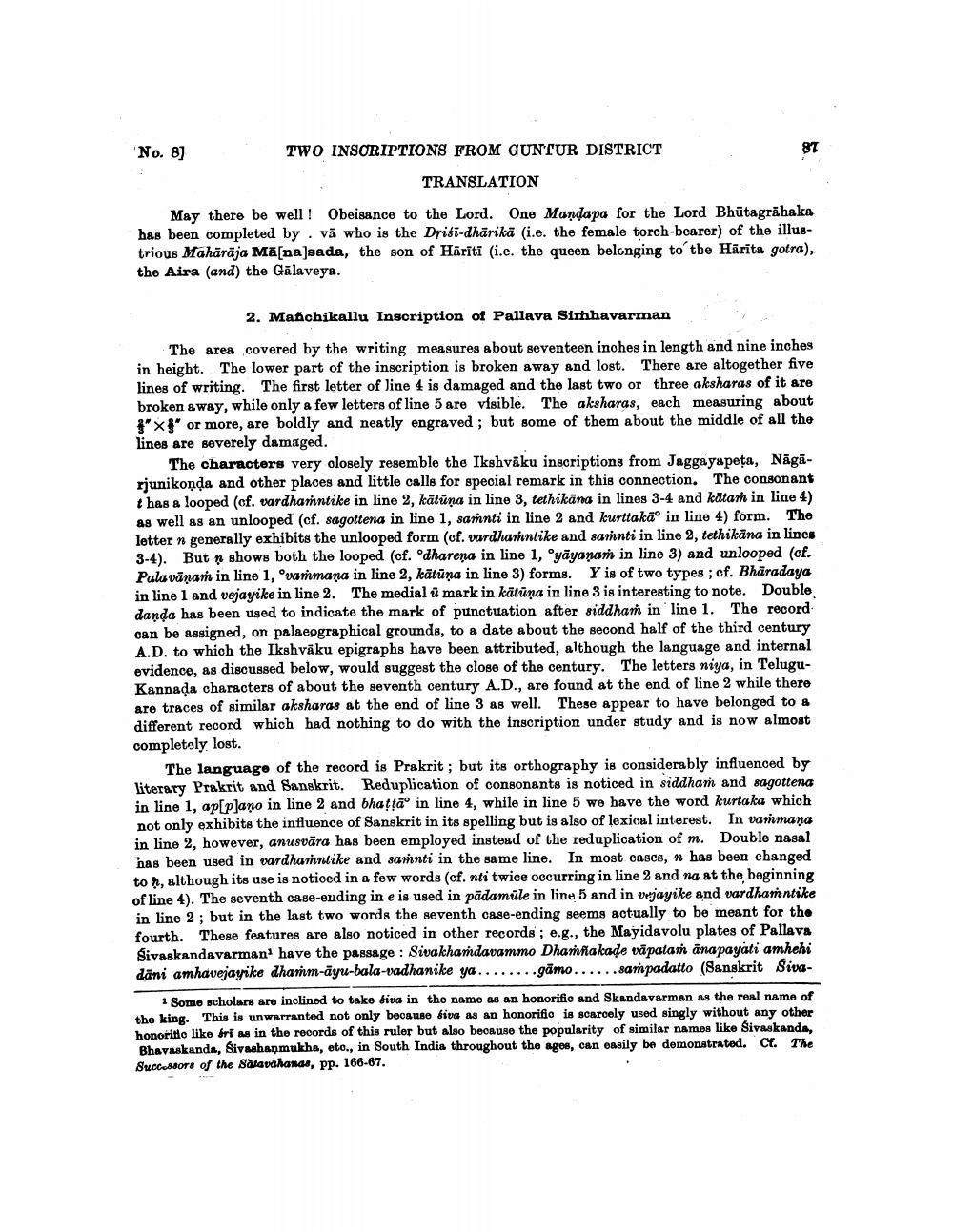________________
No. 8]
TWO INSCRIPTIONS FROM GUNTUR DISTRICT
TRANSLATION May there be well! Obeisance to the Lord. One Mandapa for the Lord Bhūtagrāhaka has been completed by vi who is the Drisi-dhārikā (i.e. the female torch-bearer) of the illustrious Mahārāja Māna sada, the son of Hārīti (i.e. the queen belonging to the Harita gotra), the Aira (and) the Gālaveya.
2. Mañchikallu Inscription of Pallava Simhavarman
The area covered by the writing measures about seventeen inohes in length and nine inches in height. The lower part of the inscription is broken away and lost. There are altogether five lines of writing. The first letter of Jine 4 is damaged and the last two or three aksharas of it are broken away, while only a few letters of line 5 are visible. The aksharas, each measuring about f"xfor more, are boldly and neatly engraved; but some of them about the middle of all the lines are severely damaged.
The characters very olosely resemble the Ikshvāku inscriptions from Jaggayapeta, Nāgārjunikonda and other places and little calls for special remark in this connection. The consonant t has a looped (of. vardharintike in line 2, kātuna in line 3, tethikana in lines 3-4 and kātam in line 4) as well as an unlooped (cf. sagottena in line 1, saṁnti in line 2 and kurttakao in line 4) form. The letter n generally exhibits the unlooped form (cf. vardhanhntike and sannti in line 2, tethikana in lines 3-4). But shows both the looped (cf. odharena in line 1, 'yāyanan in line 3) and unlooped (cf. Palavānań in line 1, ovarimaņa in line 2, kātūna in line 3) forms. Y is of two types ; cf. Bhāradaya in line 1 and vejayike in line 2. The medial u mark in kātuna in line 3 is interesting to note. Double danda has been used to indicate the mark of punctuation after siddhan in line 1. The record can be assigned, on palaeographical grounds, to a date about the second half of the third century A.D. to which the Ikshviku epigraphs have been attributed, although the language and internal evidence, as discussed below, would suggest the close of the century. The letters niya, in TeluguKannada characters of about the seventh century A.D., are found at the end of line 2 while there are traces of similar aksharas at the end of line 3 as well. These appear to have belonged to & different record which had nothing to do with the inscription under study and is now almost completely lost.
The language of the record is Prakrit ; but its orthography is considerably influenced by literary Prakrit and Sanskrit. Reduplication of consonants is noticed in siddhar and sagottena in line 1, apsplano in line 2 and bhattao in line 4, while in line 5 we have the word kurtaka which not only exhibits the influence of Sanskrit in its spelling but is also of lexical interest. In varmana in line 2, however, anusvāra has been employed instead of the reduplication of m. Double nasal nas been used in vardhamntike and sannti in the same line. In most cases, n has been changed to , although its use is noticed in a few words (cf. nti twice occurring in line 2 and na at the beginning of line 4). The seventh case-ending in e is used in pādamule in line 5 and in vejayike and vardhamntike in line 2 ; but in the last two words the seventh case-ending seems actually to be meant for the fourth. These features are also noticed in other records ; e.g., the Mayidavolu plates of Pallava Sivaskandavarman have the passage : Sivakhandavammo Dhannakade vāpatan āna payati amhehi dāni amhavejayike dhanm-ayu-bala-vadhanike ya........gāmo......sampadatto (Sanskrit Siva
1 Some scholars are inclined to take diva in the name as an honorifio and Skandavarman as the real name of the king. This is unwarranted not only becauso biva as an honorifio is scarcely used singly without any other honorito like bri as in the records of this ruler but also because the popularity of similar names like Sivaskanda, Bhavaskanda, Sivashanmukha, eto., in South India throughout the ages, can easily be demonstrated. Ct. The Successors of the Satavahanas, pp. 166-67.




